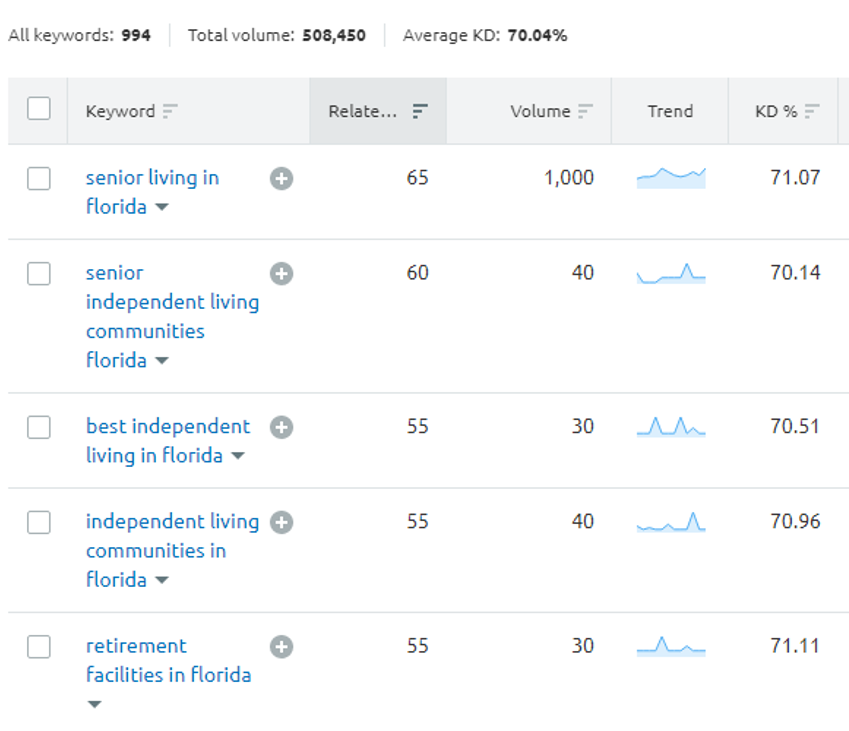Senior Living Blog Topics: How to Approach Location Keywords
Most of your senior living blog topics should be “top of the funnel” content. In other words, articles optimized for keyword phrases that will attract prospects in your area who are in the awareness stage.
The challenge with this approach: When prospects are searching for senior living options, they’re often searching on “dry” phrases like “senior living communities near me” or “senior living communities in South Florida.” (Or whatever city people are considering. You get the idea.)
You need to get creative in how you write blog content around these phrases.
It’s not enough to simply get someone to your site based on the location keyword phrase. You need to provide quality senior living blog content that inspires them to stick around. How can you do this?
Let’s use our example of “senior living communities in South Florida.”
According to SEMrush, the keyword tool that we use, people search on this phrase approximately 50 times per month. It’s a good long-tail keyword phrase to focus on. But how many engaging senior living blog topics can you get from that one keyword phrase? More than you might think!
Here’s our quick brainstorm:
- X Tips for Evaluating Senior Living Communities in South Florida
- Fun Day Trips for Senior Living Communities in South Florida
- Tips for Researching Senior Living Communities in South Florida
- Touring Senior Living Communities in South Florida? What to Ask
- Financing Options for Senior Living Communities in South Florida
- Why Consider Senior Living Communities in South Florida
- Senior Living Communities in South Florida: What to Watch For
- X Facts About Senior Living Communities in South Florida
- Senior Living Communities in South Florida: Right For You?
- Senior Living Communities in South Florida: X Considerations
You should also research related keyword phrases and brainstorm even more senior living blog topics.
We love the “related” search function in SEMrush. After we did a search on “senior living communities in Florida,” we hit the “related” button. Here’s a snap shot of the results.
Here’s a quick brainstorm of potential senior living blog topics:
- How We Deliver the Best Independent Living in Florida
- Rethinking Retirement Facilities in Florida
- We know, we know! You’re bristling at the word “facilities.” But people DO search on the term. Reclaim it and reinvent it! Take it back.
- 10 Reasons Why Nothing Beats Senior Living in Florida
- Best Independent Living in Florida: How to Tell
- Senior Living in Florida: X Things to Keep in Mind
Note: You could use ALL of the above as blog titles and title tags since they’re all within 65 characters.
While all of the proposed titles have a consistent theme, each angle is different. And a good writer can create compelling blog content that will fulfill the title’s “promise” while also finding a way to weave in aspects of your community.
Remember, the content should be helpful, not promotional.
For the article titled “Best Independent Living in Florida: How to Tell,” you could provide a solid checklist that people can use to audit the communities they’re researching and that they will eventually visit. You’d only mention your community tangentially.
For example, one of the items on the checklist might be “Read reviews about each senior living community.” And you could link that phrase to your community’s Google reviews. At the end of the article, you might include a call-to-action that says something like “Discover how our community offers the best independent living in Florida. Schedule a visit!”
Again, a skilled blog writer can help breathe life into these topics.
A good writer will understand how to write for search engines and humans. The more interesting and helpful the senior living blog content is, the better chance the person reading it will click around your site and learn more.
Remember, the goal is to get visitors to convert on something, like a Live Chat or downloadable piece of premium content. A prospect’s email address is worth its weight in gold. Because once you have it, you can continue to engage and nurture them. (Provided you have good marketing automation.)





